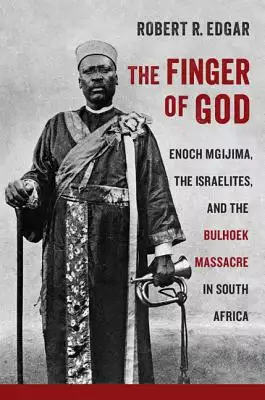Prophesize的問題,我們搜遍了碩博士論文和台灣出版的書籍,推薦Edgar, Robert R.寫的 The Finger of God: Enoch Mgijima, the Israelites, and the Bulhoek Massacre in South Africa 可以從中找到所需的評價。
國立中興大學 台灣文學與跨國文化研究所 邱貴芬所指導 王光傑的 台灣自然書寫中的烏托邦樣貌 (2012),提出Prophesize關鍵因素是什麼,來自於自然書寫、烏托邦、生態倫理、《魔神仔》、《永遠的信天翁》、《田園之秋》。
The Finger of God: Enoch Mgijima, the Israelites, and the Bulhoek Massacre in South Africa

為了解決Prophesize 的問題,作者Edgar, Robert R. 這樣論述:
On the morning of May 24, 1921, a force of eight hundred white policemen and soldiers confronted an African prophet, Enoch Mgijima, and some three thousand of his followers. Called the Israelites, they refused to leave their holy village of Ntabelanga, where they had been gathering since early 1919
to await the end of the world. While the Israelites maintained they were there to pray and worship in peace, the white authorities viewed them as illegally squatting on land that was not theirs. After many months of fruitless negotiations, the South African government sent an armed force to Bulhoek,
a village in the Eastern Cape, to expel them. In the event that has come to be known as the Bulhoek massacre, police armed with rifles, machine guns, and cannons killed nearly two hundred Israelites wielding knobkerries, swords, and spears.In The Finger of God, Robert Edgar reveals how and why the
Bulhoek massacre occurred. Edgar asks: Why did Mgijima prophesize that the end of the world was imminent, and why did he summon his followers to Ntabelanga? Why did the South African government regard the Israelite encampment as a threat? Examining this clash between a government and a millenial mo
vement, Edgar considers the Bulhoek massacre both as a signal event in South African history and as an example of similar conflicts worldwide. Robert R. Edgar, Professor of African Studies at Howard University and Stellenbosch University, South Africa, is the coauthor of African Apocalypse: The St
ory of Nontetha Nkwenkwe, a Twentieth-Century South African Prophet, among other books.
Prophesize進入發燒排行的影片
台灣自然書寫中的烏托邦樣貌
為了解決Prophesize 的問題,作者王光傑 這樣論述:
二戰後的台灣,在國際情勢與政治環境的現實下,搭上了經濟發展的順風車。從三民主義的模範省,到資本主義的模範生,這海島的人民甚至努力地為自己爭得了「亞洲四小龍」的稱號。只是在工商業不斷擴張,農村快速轉換為都市的同時,漂亮的經濟數據也給這塊土地加上了沈重的負擔:自然資源被過度消耗,生態環境因各式各樣的開發而被擠壓以致失衡。如果文學可以是土地的紀錄者與發言人,那麼台灣的自然書寫作家也著實將自身家園的美麗與困境寫入其作品中。更進一步的,為了面對這嚴峻的生態並社會環境的難題,這些作品拋棄了資本主義的運作原則,轉而向自然尋找一個平衡、和諧、且永續的生存精神,浮現了烏托邦的輪廓。 本論
文選用了三個台灣自然書寫文本,以「烏托邦」為主題做分析,期待探索出研究文本中的烏托邦是以怎樣的輪廓、姿態存在著,其內涵為何,又對台灣現實社會發出何種對話和啟示。第一個文本是王家祥的《魔神仔》,其鋪陳了一個從文明世界啟身尋找藏於台灣東部深山之神祕部族的探險路徑,主角在越來越深入森林的旅程中,不斷地對自我存在發出質疑、挑戰、並作抉擇,最終在大自然裡找回了面對生命困境的力量與勇氣。第二個文本,劉克襄的《永遠的信天翁》則以人類屠殺信天翁的歷史做為反烏托邦的鑑誡,向著一個生態復育的理想國度出發。作者透過一個研究海鳥的故事,陳明了人類必須認知對自然界其他物種的「理解」之不完全,並強調生命成長過程中進行自我
重估的重要性。如此,以尊重與檢視自我作為建立生態新關係的元素,人們才能期待一個美麗和諧的世界。第三個文本則是陳冠學的《田園之秋》。作者以農人簡約的勞動生活作為烏托邦的體現,用豐富的學問與思考尋找人在自然中的定位,並對工商社會的荒謬本質做出批判。陳冠學以自身作為知識分子「知行合一」的範本,將烏托邦從高懸之處拉下,置放於台灣南方大武山下的田野間。結論部分,筆者歸納了上述作品中,關於烏托邦想像的共同特色:以台灣本土為素材,著重自然中的自我探尋,關懷社會與環境議題,以及強調烏托邦的可實踐性。台灣的自然書寫,將這塊土地的未來擘畫於一個更和諧地與自然共存的理想,也期待在讀者的心中喚起那被功利社會矇蔽已久的
覺醒。